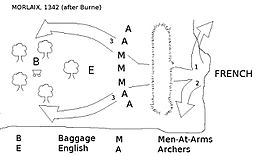Battle of Morlaix facts for kids
Quick facts for kids Battle of Morlaix |
|||||||
|---|---|---|---|---|---|---|---|
| Part of the Breton War of Succession | |||||||
 Map showing disposition of English forces during the battle. |
|||||||
|
|||||||
| Belligerents | |||||||
| House of Montfort, Brittany Kingdom of England |
House of Blois, Brittany Kingdom of France |
||||||
| Commanders and leaders | |||||||
| Earl of Northampton | |||||||
The Battle of Morlaix was fought in Morlaix on 30 September 1342 between the Anglo-Breton and Franco-Breton forces in Brittany. The Anglo-Breton under English command besieged the town, but a Franco-Breton relief force arrived. The English constructed a strong defensive position. After repeated attacks, the French forced the English to retreat into the woods, and the French force then withdrew.
Contents
War of Breton Succession
Context
In 1341 John III, Duke of Brittany died without leaving an heir. The question of the succession ignited a civil war in sovereign duchy of Brittany which lasted about 25 years initially between John's half brother, John of Montfort and his niece Joan, Duchess of Brittany, wife of Charles of Blois. Charles and Joan had the support of the Breton nobility and clergy while John was an outsider whose main concentration of power was in the Île de France. However, Charles was also the nephew of Philip VI of France who backed Joan's claim and brought outside interference, while England supported John de Montfort's claim.
Relieving the Siege of Brest
Initially, Edward III of England could do little to help the de Montforts, he had his own problems at home, but eventually he felt able to send a small force under Sir Walter Mauny to aid them. As a result of Mauny's initial successes, Edward decided to send a larger force of knights and archers under the command of William de Bohun, 1st Earl of Northampton. For a long time its departure was delayed and by the time they arrived in Brittany, John de Montfort was a prisoner of the Franco-Bretons and the struggle was being carried on by his wife Jeanne de Montfort. When Northampton landed on 18 August 1342, the Countess, her men and the remnants of Mauny's force were besieged at Brest by a large Franco-Breton army under the command of Charles of Blois and a force of Genoese ships. On Northampton's arrival the Franco-Bretons appear to have fled without bothering to engage the smaller English force and the siege of Brest was relieved.
English Relief Force Moves inland
From Brest, Northampton moved inland and there are few details of what happened during this journey but eventually he reached Morlaix, one of Charles de Blois’ strongholds.
English Siege of Morlaix
His initial attack on the town was unsuccessful and having been repulsed with slight losses he then settled into a siege.
Since Charles de Blois' forces had withdrawn from the siege in Brest, they had been growing in numbers possibly reaching as many as 15,000. Informed that Northampton's force was considerably smaller than his own Charles began to advance on Morlaix intending to lift Northampton's siege. On receiving intelligence of de Blois’ advance Northampton, not wishing to be trapped between de Blois’ force and sorties from the garrison of Morlaix, made a night march to intercept him.
Only three chroniclers give any account of the battle and they are all English: Geoffrey le Baker, Adam Murimuth and Henry Knighton. This absence of contemporary interest is possibly because the battle was indecisive and also because Brittany was somewhat of a backwater removed from the main action of the courts and armies of Edward III and Philip VI. None of the chroniclers give much detail of the battle and little of the battle orders of the two sides beyond stating that the Franco-Bretons were deployed into 3 lines. At least one of the Franco-Breton divisions was solely of mounted knights led by Geoffroi de Charny. Adam de Murimuth puts the total Franco-Breton numbers at 3000 cavalry, 1500 Janissaries by which he may mean Genoese and a mixed force of Breton infantry. The bulk of the Bretons were probably quite an ineffective force, just local levies. The English numbers are also unclear. Northampton had less than 1,500 on his arrival at Brest. He had been reinforced by Robert of Artois with another 800 and an unknown number of Bretons of unknown quality. He would have had to leave some behind to contain the Morlaix garrison so almost certainly his numbers would have been less than the Franco-Bretons but all the figures are all from English sources and thus, for the French, probably an overestimation.
Outcome of the battle
Whatever the details of the fighting, the final result was that 50 French knights were killed and 150 French captured including Geoffrey de Charny and a number of ‘populari’ which seems to indicate that at least some of the infantry were involved in the melee.
The English force now made apprehensive by the remaining French forces withdrew into the wood at their back where they were safe from a full blooded cavalry charge. What was left of de Blois’ force then evidently relieved Morlaix and the besieging English, now trapped in the wood, themselves became the object of a siege for several days.
Sources
- Sumption, Jonathan ‘The Hundred Years War Volume 1 Trial by Battle’ Faber 1992
- Burne, Lt. Col. Alfred H. ‘The Crécy War’ Greenhill 1990
- DeVriess, Kelly ‘Infantry Warfare in the Early 14th. Century’ Boydell 1996
- Ayton, A & Preston P ‘ The Battle of Crécy 1346’ Boydell 2005

